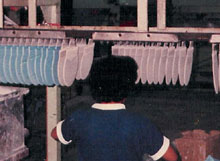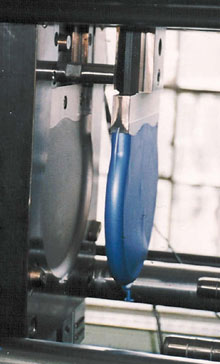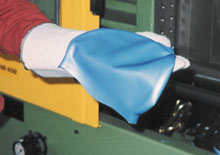Latex dipping line for Swim Caps

 The plant is in the form of a two deck conveying system comprising a closed loop in which groups of work bars carrying formers are conveyed progressively along a horizontal track at low level, elevated to a horizontal track at high level, along which they are conveyed in the return direction, and finally lowered to the low level track, completing the circuit, which is repeated automatically until the plant is stopped.
The plant is in the form of a two deck conveying system comprising a closed loop in which groups of work bars carrying formers are conveyed progressively along a horizontal track at low level, elevated to a horizontal track at high level, along which they are conveyed in the return direction, and finally lowered to the low level track, completing the circuit, which is repeated automatically until the plant is stopped.
Along the low level track the following operations are carried out in sequence:
(a) Stripping (two stations)
(b) Form Scrubbing
(c) Form Rinsing Dip
(d) Drying Oven
(e) First Coagulant Dip
(f) Drying Oven
(g) First Latex Dip
(h) Invert and Revert
(i) Second Coagulant Dip
(j) Drying Oven
(k) Second Latex Dip
(l) Invert and Revert
(m) Detacking Dip
Along the high level track the following operation is carried out:
(a) Drying and Curing
 Plant Construction
Plant Construction
The plant is robustly constructed mainly from rectangular steel tubular sections and rolled steel sections, and is designed so that it can readily be dismantled for shipment and subsequent re-erection. Dipping tanks are made from stainless steel for easy cleaning and long life. Mechanisms are of uncomplicated design to facilitate maintenance, and their. movements are actuated and controlled pneumatically.
Conveying System
Work bars, to which are attached dipping forms, are arranged in groups of six along the upper and lower conveyor tracks. These groups move progressively around the plant intermittently, so that each group moves at regular intervals from one station to the next. The frequency of movement depends upon the slowest operation, which in turn is governed by the size of bladder being made. The progressive movements of the groups are completely automatic, and comprehensive interlocks ensure that they cannot take place until each operation is completed and all work bars are in a safe position to move.

